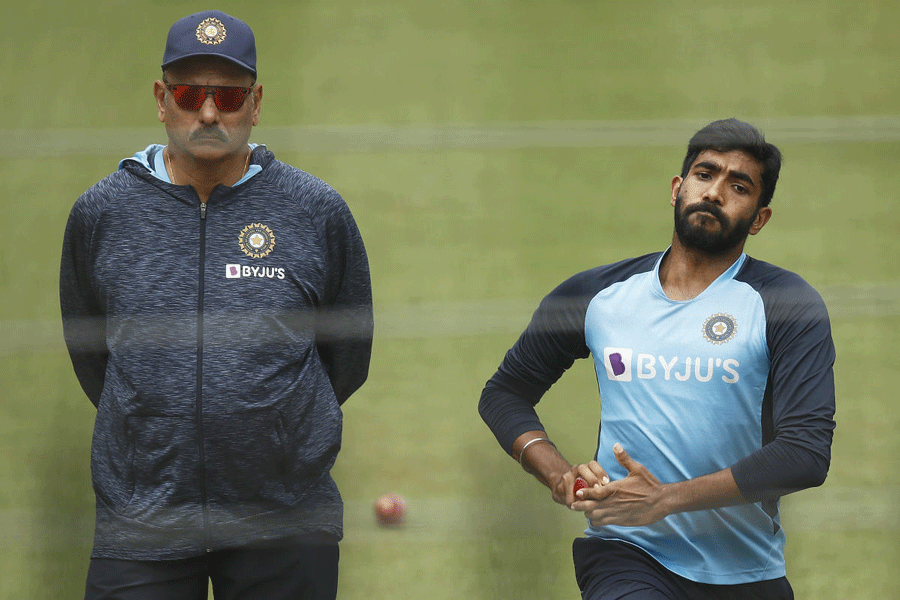Jasprit Bumrah's Test Cricket Journey and Ravi Shastri's Reflections on Indian Cricket
From White-Ball Specialist to Test Match Star, Shastri's Insights on Kohli, and the Future of the Game

Jasprit Bumrah, the speed wonder, was "desperate and hungry" to play Test cricket because he did not like the label of "white-ball specialist," as former India head coach Ravi Shastri always knew.
According to the ICC Test rankings, Bumrah is the first bowler from India to hold the top spot.
The 30-year-old's skill was on full show as he recorded an incredible match total of 9/91, crucial to India's win in the Visakhapatnam Test that leveled the series.
Shastri recalled telling Bumrah that playing a Test match would be the "biggest day" of his life during their talk, as reported in an interview with former England captain Michael Atherton published in The Times in London.
"I recall making my very first call to him from Kolkata. I inquired whether he would be keen in playing Test cricket. Shastri said, "He said that would be the biggest day of his life."
Without question, he was called a white-ball cricket player. However, I was aware. I was interested in his level of hunger. I advised him to prepare himself. I promised him that I would let him loose in South Africa.
In January 2018, Bumrah played his first Test match in Cape Town against South Africa.
"He's thrilled to be participating and performing well in Test cricket," Shastri said, refuting the idea that Bumrah was only known for his white-ball exploits during his IPL tenure with the Mumbai Indians.
He was itching to play Test matches alongside captain Virat Kohli. They are aware that nobody really recalls white ball averages at the end of the day. Your Test cricket statistics will live on in their memory forever.
Shastri emphasized the importance of Test cricket and the lasting legacy it leaves behind in response to the criticism.
A diamond that is not cut
Shastri, who became the head coach after taking over as national team director in 2014, also gave some reflections on his time in that position, highlighting the change in emphasis from individual brilliance to collective brilliance.
Shastri called Virat Kohli a "uncut diamond" and said that he had seen the captain's potential in him from a young age.
Although there was a lot of individual talent, I like to see collective talent. I saw an uncut gem in Virat Kohli and wanted to win and elevate Test cricket.
"My attention was fixed on Kohli when he was my captain, MS Dhoni." Very early in my second month, I told him, "Watch, observe, and be ready (for the captaincy). It will take time."
Shastri was grateful for Kohli's love of Test cricket, his desire to take on new challenges, and his ability to play difficult cricket.
Kohli was totally absorbed in the Test match. He had a lot of enthusiasm. He was ready to put in the hard work and play competitive cricket, which aligned with my philosophy. Playing against Australia or Pakistan requires a "no complaints" and "no excuses" mentality.
When it came to building a formidable pace force, he and Kohli were always in agreement. The rest is history as India drew a Test series in England and won two consecutive Test series in Australia.
We both agreed that we needed a succession of quick bowlers. He was prepared for a fight. He wanted to play aggressively. We let everyone loose in the nets.
"Anyone could be bounced the shit out of you." He was the first player to accept it; he was willing to seem unattractive in the nets, and others started to think differently.
In response to criticism of India's 40% income share of the ICC, Shastri offered a cautious strategy.
Although he acknowledges India's economic contribution to the game, he suggests allocating a percentage of the proceeds to help underdeveloped nations.
"They may utilize a portion of the forty percent to assist those nations that need it. Although I haven't had such discussions, I would have it in mind.
T20, in Shastri's opinion, ought to be the "vehicle" that takes the game into new arenas.
"T20 is modeled after football. It will take place. Be prepared for it because it's inevitable," he advises.
"That money will help Test cricket continue, but only if it is Test cricket, which means you need the greatest players available and the strongest sides competing against one other. It's not Test cricket until it's best against best," he said.
Shastri also remembered how the story was altered by triumphs in the 1983 World Cup and the Australian World Cricket Championship.
Some people labeled our victory in England "a fluke," but Shastri remembered that later, we traveled to Australia for the World Championship, which was the first time an Indian public had seen cricket under lights.
"Every side participating, all of the best players, and India taking on Pakistan—something that hadn't occurred in England in 1983. In March 1985, we triumphed against them in the Melbourne full house final played under the lights. That went live at prime time in India.
After we won in 1983 under Kapil (Dev) and in 1985 under Sunny (Gavaskar), people began to take us seriously, and donations, sponsorships, and advertising began to come in. I recall winning that series, and I was able to bring the automobile into the nation duty-free.
Except for the headline, this story has not been edited by Press Time staff and has been published from a syndicated feed.































































